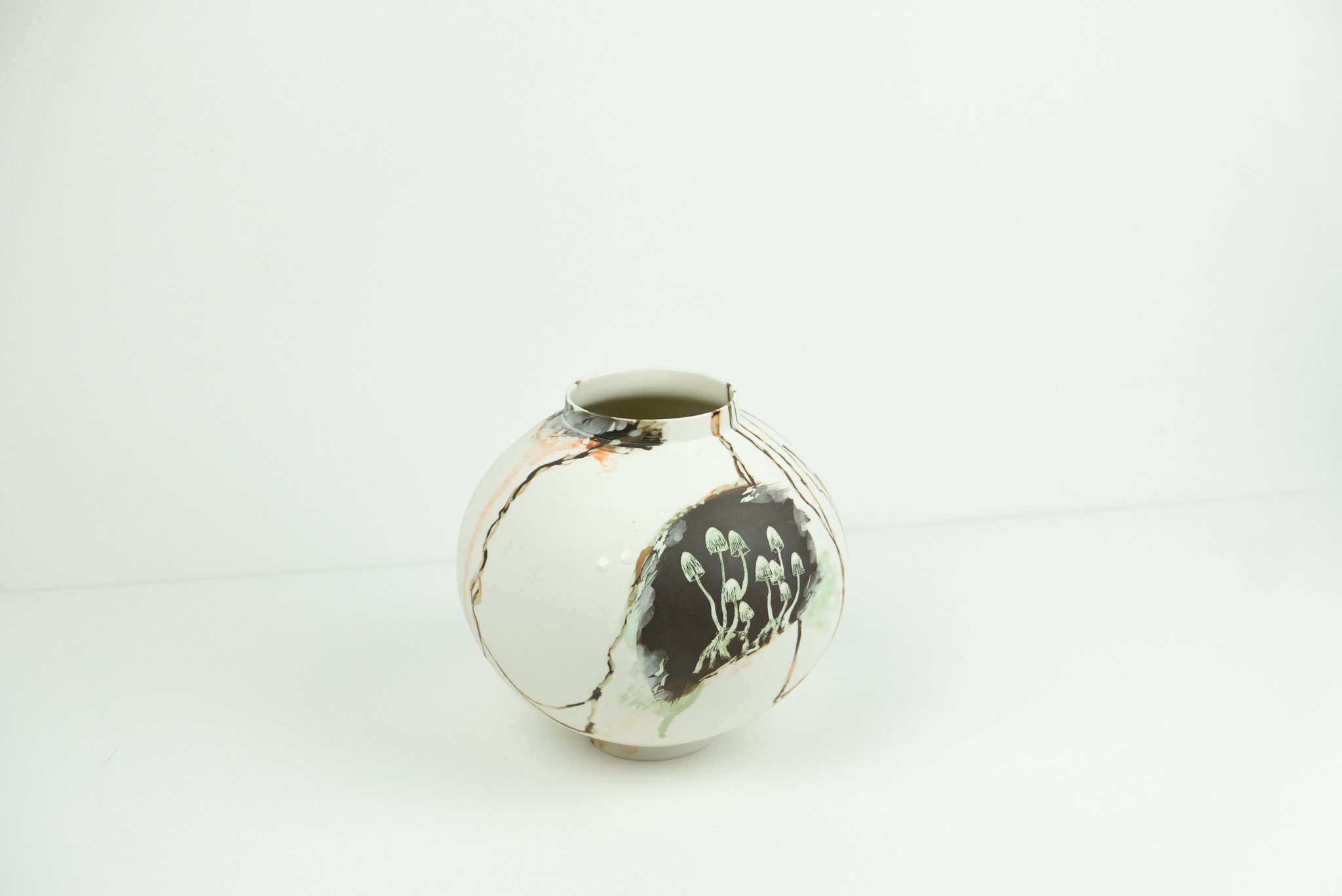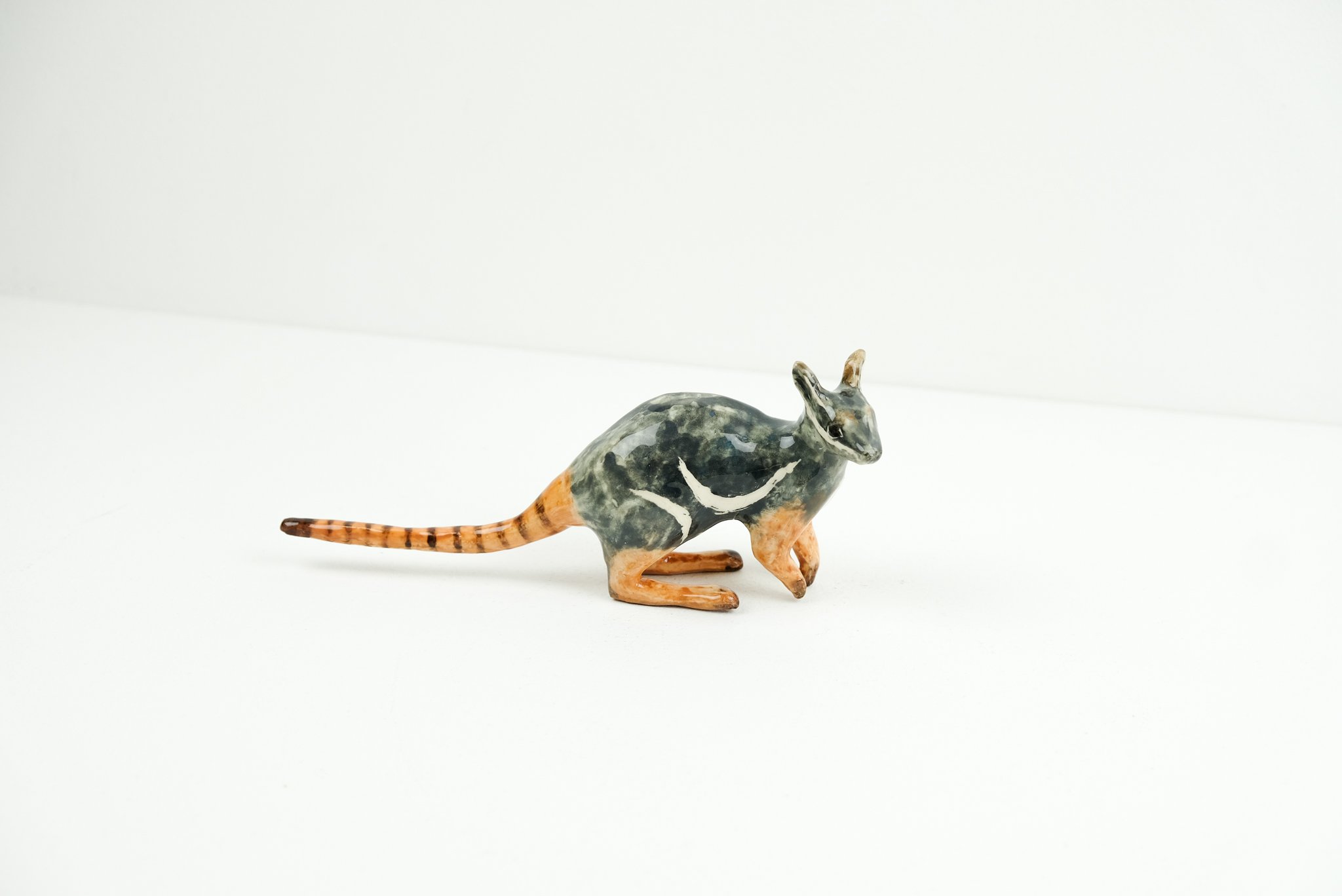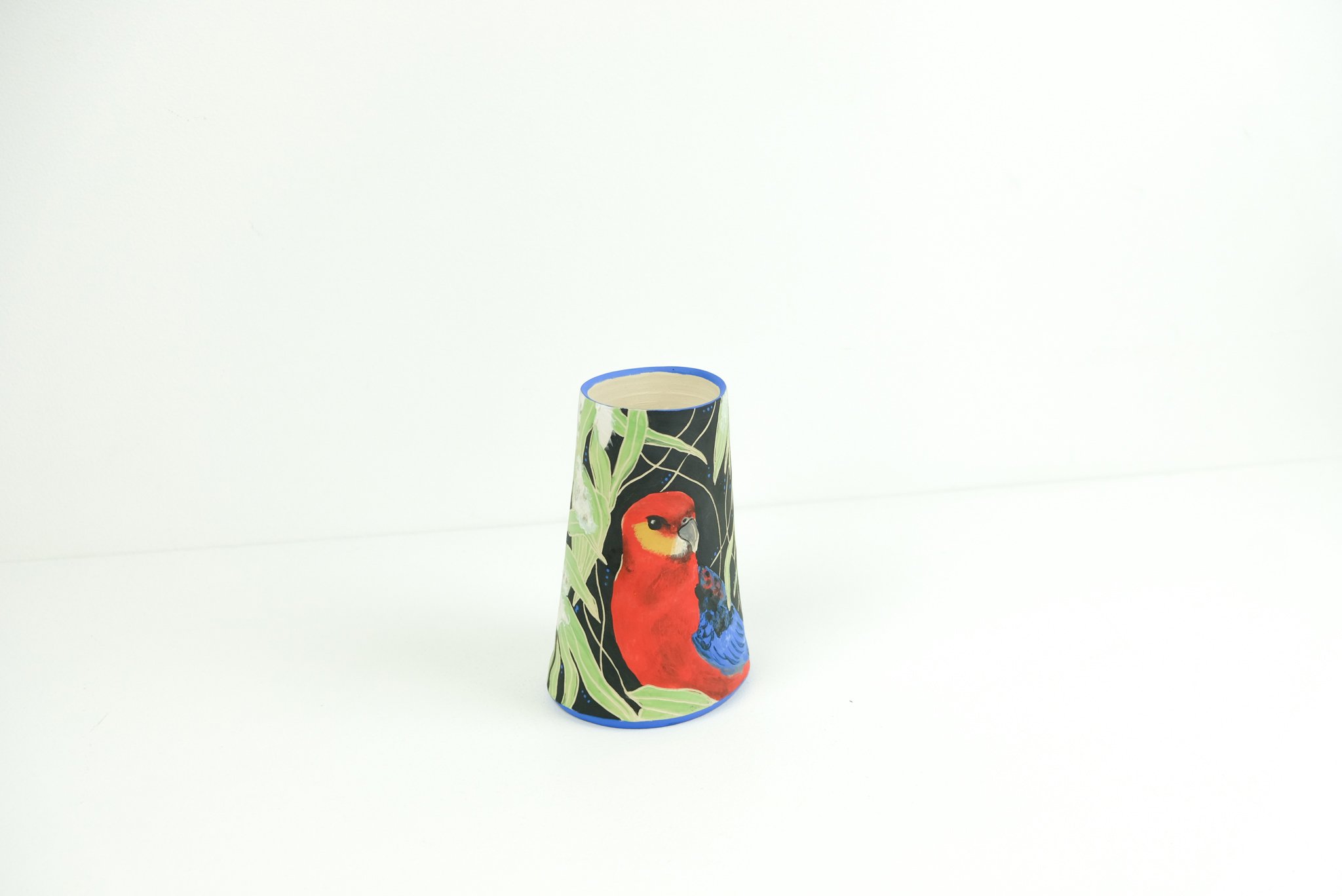Exhibition Insight... Australiana
Shannon Garson, Left-Right: Leaf Litter - Small Moon Vase; Rainforest Branches - Large Moon Vase; Sandpaper Fig - Small Moon Vase; Fungi - Large Moon Vase, 2021. Image: Shannon Garson.
Australiana
Australiana is a collection of ceramic functional ware and figures containing visual motifs that are inherently Australian. Continuing the history of handmade Australian pottery, which rose to prominence in the mid-20th century, contemporary studio artisans create ornaments and practical homewares which contain artistic interpretations of native flora, fauna
and folklore. Together they celebrate our daily rituals and reoccurring affinity to the bush.
EXHIBITORS
Amanda Bromfield (NSW)
Amanda Bromfield is a ceramic artist working on Bundjalung country in NSW. Her ceramics celebrate the beauty and uniqueness of the now endangered koala. Her koala sculptures are glazed in raku glazes made by the artist. Bromfield uses a black ash engobe made from bushfire ash collected from the Mogo State Forest during the 2019/2020 Black Summer bushfires.
Amanda Bromfield, Before and After, 2020. Image courtesy of JamFactory.
Auntie Linda Coulthard, Donna Coulthard, Lesley Coulthard and Veronica Coulthard (Ku Arts/ Ngapala Arts) (SA)
The Coulthard artists are four Adnyamathanha/Kuyani women who make ceramic works at Ngapala Arts in Copley, SA.
Donna would help her dad and uncle burn patterns into boomerangs. Now she carves these lines into the clay. Lesley learned pottery in school, which sparked her interest in ceramics. She draws where she is from, between the coal mines and the cutaway. Veronica remembers visiting Balcanoona, her grandfather Coulthard’s country, as a kid. She likes to draw landscapes and buildings.
Auntie Linda Coulthard is a proud Adnyamathanha and Kuyani elder. She was born and raised on the the Nepabunna Aboriginal Mission on Adnyamathanha Yarta, Flinders Ranges. She recalls moving to Copley in the 1950s, camping under the stars and drawing on rocks and in the mud. She would make artefacts out of the mud – like boomerangs, little dishes and figures. At Ngapala Arts in Copley, Auntie Linda draws what she sees every day: animals, bush tucker, wildflowers, native plants and the landscape.
Donna Coulthard of Ku Arts & Culture, Akurra - Dreamtime Serpent. Image courtesy of JamFactory.
Malpiya Davey (Ernabella Arts) (SA)
Malpiya (or Irpintiri) Davey is a Pitjantjatjara artist from Pukatja. Her parents’ country is to the west of Pukatja between Watarru and Iltur, close to the border with Western Australia. She decorates her ceramics with glazed or painted designs. Her designs depict various traditional bush foods from her family’s country, such as kampurarpa (desert raisins), wayanu (quandong) and ili (wild figs).
Malpiya Davey, Bush Tomatoes, 2010. Image courtesy of JamFactory.
Helen Earl (NSW)
Helen Earl creates ceramic objects, installations and sculptures inspired by environmental and social narratives using clay and found objects. Her practice explores the continuity between the domestic space and that of the surrounding natural environment.
Helen Earl, Casuarina Body Vase, 2020. Image courtesy of JamFactory.
Shannon Garson (NSW)
Shannon Garson works in Australian porcelain. She creates both handmade tableware and exhibition pieces to investigate the relationship between human activity and the infinite variety of striations, spots and marks found in nature.
Shannon Garson, Fungi - Large Moon Vase, 2021. Image courtesy of JamFactory.
Patsy Hely (ACT)
Patsy Hely’s ceramics concentrate primarily on domestic forms. Throughout her body of work she records life around where she lives or travels: birds seen, political life, local events and places, and people encountered.
Patsy Hely, Garden Cup and Plate, 2021. Image courtesy of JamFactory.
Fiona Hiscock (VIC)
Fiona Hiscock’s practice emerges from a long historical tradition of utilitarian ceramics which use nature for decorative inspiration. Oversized hand-built vases and pitchers provide a canvas upon which the artist depicts the life cycle of botanical specimens, allowing her abiding interest in the natural world to flourish. She depicts a range of location specific species including Banksia Serrata which grows along the eastern Victorian coastline and native Grevillea found in Arnhem Land.
Fiona Hiscock, Eucalypt Ficifolia and Rainbow Lorikeet Vessel, 2021. Image courtesy of JamFactory.
Annabel Hume (SA)
Adelaide-based Annabel Hume makes ceramics inspired by the fragility of ancient Australia’s endangered and diminishing flora and fauna. Each piece is hand-built, then painted using sgraffito before glaze firing.
Annabel Hume, Yellow Footed Rock Wallaby, 2022. Image courtesy of JamFactory.
Denise McDonald (NSW)
Sydney-based Denise McDonald was trained in potteries across England and Australia. She creates several ranges of ceramic tableware that celebrates our unique Australian flora, heritage decorative patterns and motifs, found textures and rich glazes. Her flannel flower range features a 100-year-old pattern sourced from a Federation house in Sydney.
Denise McDonald, Cake Stand, 2021. Image courtesy of JamFactory.
Daisybell Nungala Virgin (NT/SA)
Daisybell is originally from Ali Curung, near Tenant Creek, NT. She would draw pictures in the sand and make things from clay as a young child. In 2009 she undertook a mentorship with Chilean artist Silvia Stansfield at JamFactory’s ceramic studio alongside Kaurna, Boandik and Ngarrindjeri artist Christina Gollan. Daisybell
Daisybell Nungala Virgin, Bush Tucker, 2010. Image courtesy of JamFactory.
Maricelle Olivier (NSW)
South African born Maricelle Olivier immigrated to Australia in 2007. She was previously the Ceramics Studio Manager at Ernabella Arts Centre. Her Love Bird series is inspired by the surrounding Australian indigenous avifauna and flora, portraying a celebration of love and adoration for these vivid Australian icons. Depicted in their equally colourful natural environment, each Love Bird vessel combines ceramics and detailed hand paintings, romanticising the representation of Australian birds.
Marcielle Olivier, The Western Rose, 2019. Image courtesy of JamFactory.
Hannah Vorrath-Pajak (SA)
Hannah Vorrath-Pajak is a studio potter and visual artist currently works in porcelain. She makes heirloom wheel-thrown functional ware and precious objects as she explores her cultural heritage, traditional ceramics, and craftmanship within her work.
Hannah Vorrath-Pajak, Frilled Teacup in Celadon, 2021. Image courtesy of JamFactory.
Edna Ambrym, Michelle Yeatman and Philomena Yeatman (Yarrabah Arts & Culture Centre) (QLD)
In the early 1970s, pottery was introduced to Yarrabah as an initiative of the QLD government. Michelle Yeatman, a Gunggandji woman, started at Yarrabah Arts Precinct
in 1982 as an apprentice, inciting a life-long interest in ceramics.
Fellow Gunggandji artist Philomena Yeatman began her career at the Yarrabah Art’s Precinct in 1991, firstly experimenting with ceramics, print, weaving and painting. Philomena is a renowned weaver whose grandmother taught her to make baskets and mats using pandanus and traditional dyes found on Country.
Edna Ambrym is a Gunggandji/Eastern Kuku Yalanji practising artist who has been part of the Yarrabah Arts & Culture Centre for over 10 years.
The Hairy Men and the Little people ceramic works produced by the Yarrabah Artists are their interpretations of encounters with them or stories passed on by the Old People.
Edna Ambrym, Hairyman, 2021. Image courtesy of JamFactory.
The Hairy Men and the Little People
by Philomena Yeatman
“My grandmother and father told me about the Hairy Men and the Little People. Others call the Little People the missing tribe. There are a few types of Hairy Men and Little People living around Yarrabah. Bina Bina man is tall and big. Bina Bina woman is bit smaller. They have really long ears and are really smelly. One night a man was driving up around Angel Bend, he was heading back to Cairns when he saw this fella in a big coat walking up the road. When the man got closer, he realised it was Bina Bina. Bina Bina wasn’t wearing a coat – it was his ears covering his body. The man got a big fright and took off.
There is one Hairy man that looks like a lizard. We see him all over. We have a shack around the point on the beach. I heard something come up on the step. When I opened the door, I saw him. I then went outside to see if I could see him, but he was long gone.
There is one other man who lives near the waterfall area at Yarrabah. One day my grandmother and other grannie were walking home from fishing near the point. When they got near the waterfall my grannie who was at the back heard a noise in the bush. She looked, and saw a very black tall big man with warts all over his face. It was the same man my uncle would leave tobacco out for when he was camping down at the waterfall. When my grannie saw the big tall man, she said ‘not you again’. She said she wasn’t scared.
One day my Nanny and Pop were walking to a place called Bulburro, to collect yagal [pandanus] for weaving. They came across some little people painted up in ceremony colours. So my grandfather told my grandmother to keep walking along. He then stood up and talked to the little people. He was talking language to them and he asked them where they were going. They told him that they were going for a meeting at King Beach. They had spears. My grandparents saw the little people a lot. The little people left them alone.
Wundju is the name of a type of one-legged man who looks like a bird and smells really bad. He is in the mangroves and my sons say they smell his stink. He tried grabbing my sister one night when we were camping at Woring. He heard her crying in the night and he came for her. My dad got up and lit a fire and Wundju went away.
The Lost People are everywhere but they are shy and usually only come out at night. But sometimes you will see evidence of them during the day. Sometimes you see their fire smoke coming out of the rainforest. I sit on the back veranda with my grandchildren and look up in the hills. I say to the kids when they are naughty, ‘those Little People and Hairy Men are watching us all the time. You better be good or they will come for you tonight!’.
Australiana is currently showing at JamFactory at Seppeltsfield until 15 May 2022
Works from this exhibition are available to purchase from the JamFactory online store.














